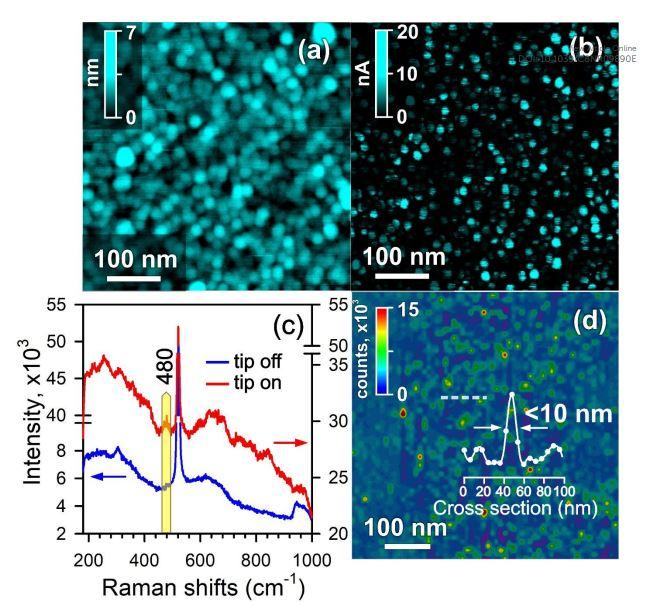New way of optical visualization of nano objects proposed

Figure 1. (a) AFM topography and (b) dc electrical current map of the 50 nm thick TiON film. (c) Far-field (tip off) and near-field (tip on) Raman spectra, and (d) TERS mapping at 480 cm-1 of the same film. Credit: Kazan Federal University
High-resolution optical microscopy methods promise breakthroughs in materials science, biology, and medicine. Today, their possibilities basically reach those of scanning electron microscopy.
Sergey Kharintsev, Head of Nano-Optics Laboratory (Kazan Federal University), comments, “The main advantage of optical microscopy is that it provides nondestructive chemical analysis of single molecules exposed to continuous-wave low-powered laser light.
Unlike scanning electron microscopy, this allows one to perform 3D visualization and spectral analysis of intrinsic structure of nano objects, and also get insights into processes in living cells.”
According to Professor Kharintsev, fluorescence microscopy has become the most popular method for biology and medicine lately. Its main drawback is the need for fluorescent labels that must be photostable and non-toxic. Furthermore, there are factors of labor-intensive sample preparation and fluorophore prices.
The paper posits that one of the solutions for ultrahigh resolution microscopy is a superlens, first proposed by John Pendry (Imperial College London, UK) in 2000. The lens looks like a sandwich with a metallic film placed between two dielectric layers.
Superresolution is achieved due to the optical near-field enhancement through surface plasmon resonances. Lately, a breakthrough initiative in practical implementation of such superlens has been put forth by Vladimir Shalaev (Purdue University, USA), who suggested using a nano-composite metal-dielectric film. This permits the superlens to be operated at a tunable single frequency.
“We propose to use a nano-structured metal-dielectric film that exhibits a double epsilon-near-zero behavior near the percolation threshold,” continues Sergey Kharintsev. “The material in question is titanium oxynitride, a compound first synthesized by Andrei Mihai's group at Imperial College London.
Such a superlens provides ultrahigh spatial resolution due to stimulated Raman scattering. Consequently, we have succeeded to achieve a spatial resolution of 8 nm and 80 nm in the near-field and far-field, respectively. Importantly, obtained optical images are formed with a standard objective only, not using optical nano-antennas, designed laser beams, or fluorescent labels.”
###
The research has been supported by the Russian Science Foundation. The project's title is “Synthesis and research of ultra-thin magnetic heterostructures with potential spintronic and optronic applications”; Professor Lenar Tagirov (Institute of Physics, Kazan Federal University) is at the helm. Sergey Kharintsev's PhD student Anton Kharitonov has prepared his PhD thesis based on the results.
Media Contact
All latest news from the category: Physics and Astronomy
This area deals with the fundamental laws and building blocks of nature and how they interact, the properties and the behavior of matter, and research into space and time and their structures.
innovations-report provides in-depth reports and articles on subjects such as astrophysics, laser technologies, nuclear, quantum, particle and solid-state physics, nanotechnologies, planetary research and findings (Mars, Venus) and developments related to the Hubble Telescope.
Newest articles

High-energy-density aqueous battery based on halogen multi-electron transfer
Traditional non-aqueous lithium-ion batteries have a high energy density, but their safety is compromised due to the flammable organic electrolytes they utilize. Aqueous batteries use water as the solvent for…

First-ever combined heart pump and pig kidney transplant
…gives new hope to patient with terminal illness. Surgeons at NYU Langone Health performed the first-ever combined mechanical heart pump and gene-edited pig kidney transplant surgery in a 54-year-old woman…

Biophysics: Testing how well biomarkers work
LMU researchers have developed a method to determine how reliably target proteins can be labeled using super-resolution fluorescence microscopy. Modern microscopy techniques make it possible to examine the inner workings…





















